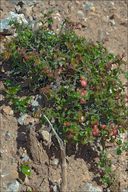|
|
click photo for larger file

Quercus coccifera
Kermes Oak
|
Photographer: Dr. Amadej Trnkoczy
ID: 0000 0000 0716 0096 (2016-07-03)Copyright © 2016 Dr. Amadej Trnkoczy
|
|
INFORMATION PROVIDED WITH THE PHOTO
|
date of photo Apr 26, 2016
latitude 35.36129 longitude 23.90723
View on Google Maps.
location
At the foot of White Mountains, north of Omalos plateau, next to the road from Omalos to north shore of the island, somewhat lower after the highest point of the road; West Crete, Mediterranean Sea (Krete, Greece)notes Slo.: no name. - syn.: (Quercus calliprinos Webb.) - Habitat: light mountain cypresses (Cupressus sempervirens) wood, moderately steep mountain slope; north aspect, among grasses; rocky, skeletal ground; full sun; elevation 1.030 m (3.400 feet); average precipitations ~ 1.000 mm/year, average temperature 8-10 deg C (estimated ?), Mediterranean phytogeographical region. Substratum: soil. Comment: This variable, evergreen shrub (or three) is known from all Mediterranean countries, also from North Africa. It grows in Croatia, but not in Slovenia. Its habitus is very variable, from very small shrub (like the one on my pictures) to up to 15 m tall tree. It is interesting that it can persist as a small shrub for many years constantly fighting against grazing animals with its thorny leaves. But when, after many years, it reaches a certain size it can 'suddenly' grow to a tall tree (this happens especially often in east Mediterranean). Its two 'faces' are so distinct that botanists had considered its tree form as a different species (or subspecies) for a long time. The name of it was Quecus calliprinos (Quercus coccifera ssp. calliprinos). Also the species name of this plant is a kind of lapse. Word coccifera means bearing berries. But these red berries, which can be often seen on this plant, are not its berries but malformed leave tissue caused by an infection with the insect Kermococcus vermillio. A red cloth dye Kermes is derived from these dried female scale insects. Also the bark of the tree was used for another dye. This one was black. Ref.: (1) I. Schӧnfelder, P. Schӧnfelder, Kosmos Atlas Mittelmeer- und Kanarenflora, Kosmos, (2002), p 26. (2) M. Blamey, C. Grey-Wilson, Wild Flowers of the Mediterranean, A & C Black, London (2005), p 31. (3) R. Domac, Flora Hrvatske (Flora of Croatia) (in Croatian), Školska Knjiga, Zagreb (1994), p 47. (4) V. Papiomytoglou, Wildblumen aus Griechenland, Mediterraneo Editions, 2006, p92.camera Nikon D700/Nikkor Micro 105mm/f2.8
contributor's ID # Bot_951/2016_DSC11690 photo category: Plant - tree/shrub
|
MORE INFORMATION ABOUT THIS PLANT
|
| common names
Kermes Oak (photographer)
View all photos in CalPhotos of Quercus coccifera Check Google Images for Quercus coccifera |
|
The photographer's identification Quercus coccifera has not been reviewed. Click here to review or comment on the identification. |
|
Using this photo The thumbnail photo (128x192 pixels) on this page may be freely used for personal or academic purposes without prior permission under the Fair Use provisions of US copyright law as long as the photo is clearly credited with © 2016 Dr. Amadej Trnkoczy.
For other uses, or if you have questions, contact Dr. Amadej Trnkoczy amadej.trnkoczy[AT]siol.net. (Replace the [AT] with the @ symbol before sending an email.) |
|
|
